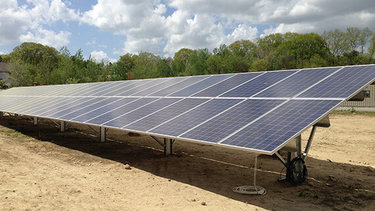Knox close to PILOT for private solar array, installation of municipal array
KNOX — The sun is out for solar in Knox, with two projects, one big and one relatively small, nearing completion.
Construction of the big project — a 5-megawatt array proposed by RIC Energy, conditionally approved by the Knox Planning Board to be built on Thompsons Lake Road — has been hung up as the Knox Town Board negotiates a payment-in-lieu of taxes agreement with the solar developer.
Although a full agreement has yet to be formalized, Knox Supervisor Russell Pokorny told The Enterprise this week that RIC has agreed to the town’s request for annual payments totaling $30,000 a year with a 2-percent escalation clause over a period of 15 years.
Pokorny said that the town’s attorney, Michelle Storm, is still negotiating small details of the contract with RIC’s counsel, but that overall, it’s “probably a good agreement now.”
Originally, RIC proposed an annual payment of $25,000 to all entities that have tax jurisdiction over the 66-acre parcel the company is leasing, with Albany County and the Berne-Knox-Westerlo School District taking the bulk of that money, leaving Knox with around $1,400 per year, plus any escalations.
After the town objected to that deal, arguing that, being the party with the most at stake, it should receive more money than the school and county, RIC offered to implement a host-community agreement wherein it would pay an extra sum of money on top of the PILOT payments, with the first annual payout being $14,352.10 and escalating to almost $19,000 by the 15th year, as The Enterprise reported at the time.
But even the $55,000 that RIC will pay out per year under the proposed agreement represents a steep discount for the company; Pokorny estimated that RIC would otherwise be paying $200,000 annually in property taxes.
PILOTs for renewable energy companies exist in New York to incentivize those companies to build projects they might not otherwise as the state races toward its goal of powering itself with 100-percent renewably-generated electricity by 2040.
Despite the apparently worthwhile cause of furthering green energy development, some municipalities, like Guilderland and New Scotland, insisting on collecting the full amount in taxes, have declined to enter into PILOT agreements with developers, while others, like Westerlo, which has five agreements in place, have expressed regret after agreeing to PILOTs.
“I think a majority of the companies we deal with in the PILOT programs are late payers,” Westerlo Supervisor Matthew Kryzak told The Enterprise in July. “It creates a new set of issues that we didn’t have before. With the amount of time we have to spend dealing with the five commercial solar farms, I’m not sure where Westerlo sits right now that there’s much of a benefit.”
One of Westerlo’s arrays is at the intersection of routes 405 and 32 in South Westerlo, which Kryzak described as a once-scenic area; the area has been nicknamed “Solar Westerlo” by residents, Kryzak said.
“Giving up beautiful, agricultural land and scenic lands hasn’t made us any friends within the town,” he said.
Municipal array
The second project in Knox is the town’s own solar array, to be built on Street Road on the site of a former landfill, using a $130,000 grant Knox received from the New York State Energy Research and Development Authority in 2017 after being designated a Clean Energy Community.
Pokorny told The Enterprise that he hopes the approximately 80-kilowatt array will be completed this fall, and that he and Deputy Supervisor Dennis Cyr were at the property this past weekend with National Grid to stake out where power-line poles will need to be built.
Some minor work will need to be done on the property to prepare it, Pokorny said — like widening the driveway and cutting down some trees that risk dropping branches on the panels — but that a work order is in, “so we’re getting closer.”
The array, which is being built by SunCommon, will cost the town around $99,000, while each of the six poles required will cost $5,000, Pokorny said, for a total of $129,000. Because the town already spent around $8,700 of the grant on LED lights for its baseball field, the town will have to spend some of its own money to cover the gap, Pokorny said, though he added that it would depend on whether all six poles will actually be needed.
Former Supervisor Vasilios Lefkaditis told The Enterprise last year that the array is expected to offset “all or a good portion” of the town’s annual $9,000 electricity bill.


